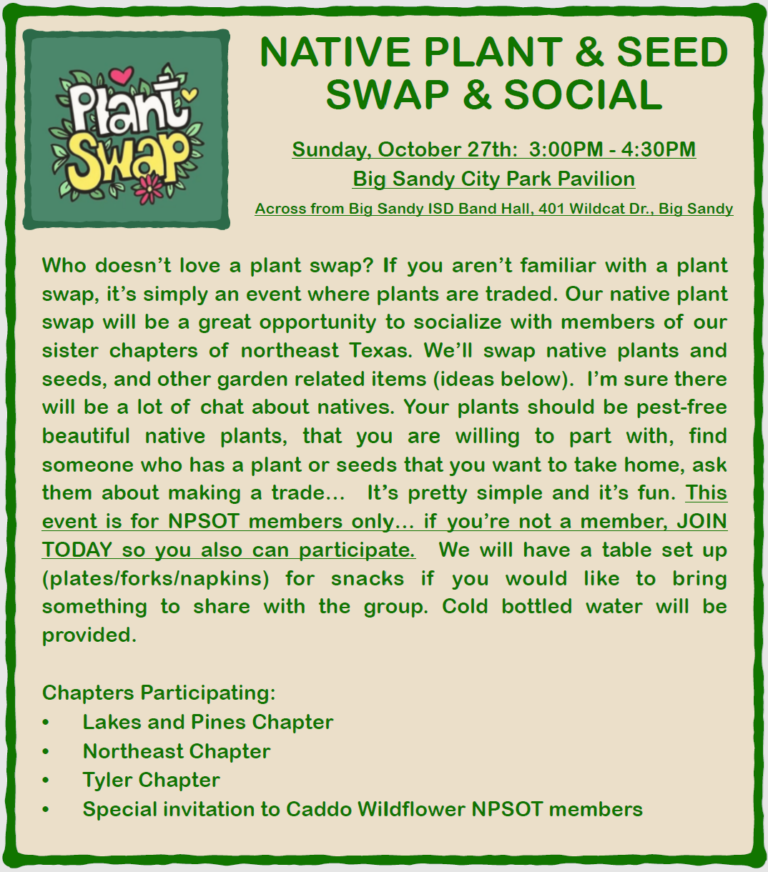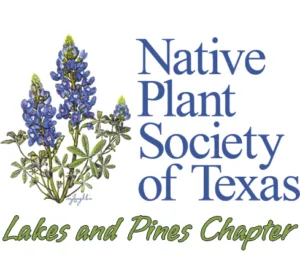Welcome to the Lakes and Pines Chapter
of the Native Plant Society of Texas
Founded in November of 2023 with the great support of our members and volunteers, the Lakes and Pines Chapter, a 501(c)(3) organization, promotes research, conservation, and utilization of native plants and plant habitats of Texas through education, outreach, and example. Our chapter includes Wood and surrounding counties. The Lakes and Pines Chapter takes in two Level 3 Ecoregions, East Texas Plains and the Western Gulf Coastal Plain. With towering pines and hardwoods, rolling hills and prairies, and lakes too numerous to count, this area has an average of 45” of rainfall annually and enjoys a wide range of plant and wildlife habitats.
As you explore our web site, you’ll find a variety of useful local information and resources, chapter news and events along with exciting programs and activities. We encourage you to get involved through membership, as a volunteer, or simply as someone interested in ecosystem sustainability. Utilize the resources provided by this website and the Native Plant Society of Texas to support the conservation and utilization of native plants and plant habitats.

The Lakes and Pines Chapter of the Native Plant Society of Texas Wishes Everyone a Merry Christmas and a Happy New Year !
Thank you for helping to make our inaugural year a success. Join us at Sorelle Farms for our next Chapter Meeting on February 5th. 2025 is going to be a fun year for our Lakes and Pines Chapter!
What's So Great About Native Plants?
Native Plants . . .
- Have grown and survived here for over 500 years
- Are drought-tolerant, naturally conserving our precious water resources
- Don’t need special pampering or fertilizing: some native plants can thrive in a variety of conditions, but most need a defined climate, soil, light and amount of water
- Are natural to their ecosystem: Texas has over 5000 native plants but very few grow state-wide
- Help us maintain biological biodiversity
- Provide habitat and food for birds, butterflies, bees and other wildlife

Lakes and Pines Chapter Meetings and Events
Our meetings are in person and open to the public. Chapter Meetings are generally held at 2:00pm on the first Wednesday of the month.
• 1:30PM – Greeting friends old and new
• 2:00PM – Meeting begins, starting with a special presentation about native plants or related topics followed by a brief business meeting.
• We currently meet at Bob Wells Nursery @ Sorelle Farms located at 975 County Road 2220 in Mineola, TX. Join us and bring a friend!
Monthly Doorprizes – Really cool items are being donated by our members for doorprizes. Get one ticket for a $1 donation or 5 tickets for $3. Winner(s) announced at end of monthly meetings. We appreciate your support of our fundraising efforts!
Lakes and Pines Chapter News

Dec. 4: Celebrating Lakes & Pines 2024 Inaugural Year!
All Lakes and Pines Chapter members are invited to join us for our Members’ Board Election & Holiday Social at Sorelle Farms, 2:00 – 3:30pm, December 4. We will be celebrating

November 6: Lakes & Pines Chapter Meeting – “Pocket Prairies” with Missy Singleton
If you love native plants and gardening that benefits our local wildlife, join us for Missy’s presentation on how Pocket Prairies serve as mini ecosystems supporting local wildlife and promoting

October 27: Native Plant / Seed Swap & Social
Our native plant swap will be a great opportunity to socialize with members of our sister chapters of northeast Texas.
Native Plant Society State Virtual Events
These on-line virtual events, sources of a wide variety of valuable information, are produced by NPSOT Chapters around the state and are available to all members.
Native Plant Society State News

Spring Plant Propagation Class with NPSOT
Join the Lindheimer Chapter’s spring class with Craig Bruska. Director of Education for the Lindheimer Chapter. The class will be held at the Tye Preston Memorial Library on Saturday, March

Lindheimer Chapter Plant Sale and Certification Program
These two events will be held simultaneously at the Tye Preston Memorial Library. The plant sale is held on the back porch from 10-2. NLCP will be held from 10-4:30.


November 2024 Plant of the Month
This month, we’re celebrating Verbesina virginica, better known as Frostweed! With its delicate white blooms that attract butterflies and bees in the fall, Frostweed also showcases a winter wonder- beautiful
We are pleased to announce that the Bob Wells Nursery at Sorelle Farms in Mineola is a NICE nursery! They have become a partner in the NICE (Natives Improve and Conserve Environments) Native Plant Partner program, a collaboration between the Native Plant Society of Texas and local nurseries around the state to offer native plants that are right for the local environment. For more information about the Bob Wells Nursery at Sorelle Farms, click here. To search for other area nurseries supporting the NICE Native Plant program click here. PLEASE SUPPORT OUR NATIVE PLANT PARTNERS!
Keep Up With Our Chapter Activities Through Facebook, Instagram, YouTube, or Email Us




